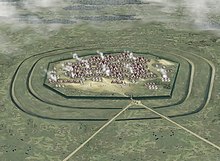Butmir culture
It is characterized by its unique elaborately decorated pottery and anthropomorphic Figurines, and is one of the best researched European cultures from 5100 to 4500 BC.
The Butmir culture was discovered in 1893, when Austro-Hungarian authorities began construction on the agricultural college of the University of Sarajevo.
They were largely responsible for the International Congress of Archaeology and Anthropology being held in Sarajevo in August 1894.
The site likely consisted of parallel rows of houses ranging from four to ten meters in length.
The diet of the Okoliste people consisted mainly of cattle, emmer, einkorn, and lentils.
This discovery was monumental, and sparked an international meeting of archaeologists and anthropologists in Sarajevo in August 1894.
The vast majority of ceramic products were simple, intended for storing food supplies, for holding water and for cooking.
In terms of surface treatment and decoration of fine ceramic vessels, they can be divided into three groups: At Butmir sites, 72 human figures made of baked clay were found.
There are 3 main groups of found figures that showed racial characteristics of Negroid, Armenoid and European races.

